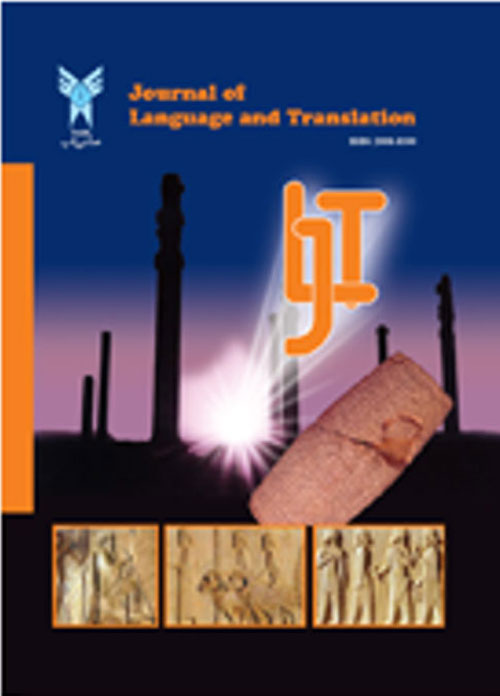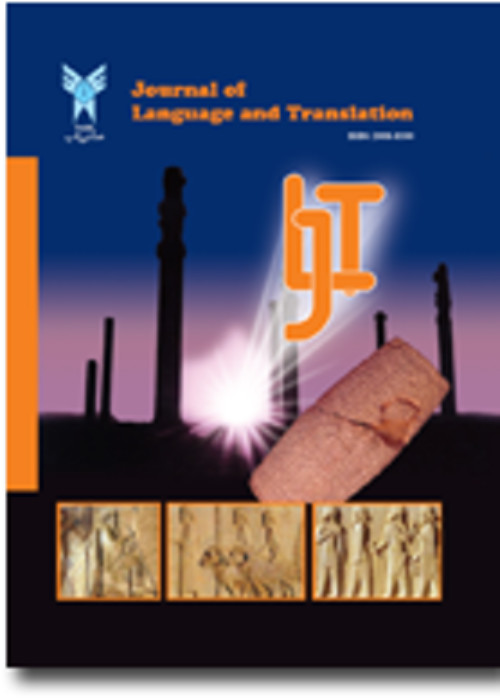فهرست مطالب

Journal of Language and Translation
Volume:8 Issue: 1, Spring 2018
- تاریخ انتشار: 1397/03/25
- تعداد عناوین: 7
-
-
Pages 1-14Ethics is a crucial issue in the different dimensions of human life; hence, there seems to be a dire need for research to be conducted on ethics in different domains including translation studies and interpreting. This qualitative-exploratory research aimed at investigating the attitudes and strategies of applying ethics in in- terpreting through employing a triangulation method. Twenty interpreters sat for an interview and a ques- tionnaire, and the contents of three video clips were analyzed to detect ethical codes through axial coding in Grounded theory. Twenty-four detected codes were divided into three groups of pre-task (in-built) attitude (six codes), while-task (delivery) strategy (15 codes), and post-task (three codes) of dynamism of ethics in interpreting, and then the percentage of the participants who had pointed out each of these codes was calcu- lated. Since 15 codes out of these 24 codes were allocated to while-task strategy and seven out of these strategies were pointed out as very important codes of ethics, it was concluded that ethics in the while-task process of interpreting plays a more significant role than in pre-task and post-task during a task of interpret- ing. Also, 12 effects of considering professional ethics in the quality of interpreting were extracted from participant's words. Alongside designing a course of study named ethics in interpreting and establishing an interpreting syndicate are the most important implications of this research.Keywords: Attitude, Ethics, Interpreting, Strategy
-
Pages 15-30The present corpus-based study addressed the strategies applied in translating the cultural elements (CEs) of the Iranian resistance literature into English. The corpus comprised Chess with the Doomsday Machine, Eternal Fragrance, and Fortune Told in Blood translated by Sprachman, Omidvar, and Ghanoonparvar, re- spectively. The Persian books and their English translations were analyzed on three separate levels: On the textual level, CEs were identified and compared with their English equivalents. The findings indicated that the most frequently used strategy is retention. Regarding the first book, Sprachmans approach, as an Eng- lish native translator, has been SL-oriented. On the semiotic level, the book cover, and on the paratextual level, Sprachmans preface, where he has introduced the characters of the story and has provided explana- tions on the Iran-Iraq War, have been intended to attract the TL readership. On the other hand, Omidvar and Ghanoonparvar, as Iranian translators, have had a TL orientation. On the paratextual level, Omidvar has provided information about neither the Iran-Iraq War nor the characters. Ghanoonparvar has given some information about the Iran-Iraq War and the story characters. On the semiotic level, Eternal Fragrance has striking differences with the source in Persian while Fortune Told in Blood is similar to its Persian coun- terpart.Keywords: Cultural elements, Paratextual analysis, Resistance literature, Semiotic analysis, Textual analysis
-
Pages 31-42Apologies are sources of problems in the process of Persian-English subtitling as they are performed with variant forms and functions in these two languages and cultures. Taārof apologies-Persian apologies which are extended to show politeness-creates more serious obstacles for the subtitlers. These difficulties root in the culture-specific contexts in which they are used as well as the cultural norms underlying their practice in Persian. This study qualitatively analyses the difficulties encountered by Persian-English sub- titlers of Iranian films in both understanding of taārof apologies in the source text (ST) and their translation into the target text (TT).The results revealed that besides the subtitles applied for translating taārof apolo- gies, different elements help the subtitlers to transfer their meaning into English subtitles. These elements are speakers and the hearers utterances as well as the end act in the conversation and also the verbal and non-verbal signs in the conversation and the previous and next scenes.Keywords: Context, Cultural norms, Iranian interpersonal relationship, Subtitling, Taa?rof Apology
-
Pages 43-55The completion mode (individual, collaborative) of the tasks and the conditions under which these modes are performed have been reported to play an important role in language learning. The present study aimed to investigate the effects of employing text editing tasks performed both individually and collaboratively, on the achievement of English grammar under explicit and implicit learning conditions. Eighty-four English learners participated in this study. Some text editing tasks were developed regarding the target grammatical structures and presented to the participants under the explicit and implicit learning conditions. Their gram- mar achievement was operationalized through a multiple-choice recognition test. The results indicated that there was no significant difference between the effect of implicit and explicit conditions when editing tasks were performed individually, but collaborative completion of this task resulted in a significantly higher grammar achievement under explicit condition than implicit one. The comparison of the individual and col- laborative performance of the task, under implicit and explicit conditions, revealed no significant difference under implicit condition. Collaborative completion of the task under explicit condition, however, proved to yield higher levels of grammar achievement when compared with the individual mode of performance.Keywords: Editing task, Explicit condition, Implicit condition, Language achievement
-
Pages 57-64This study aimed to explore the role of language type in personality ethic- as a social paradigm. To do so, 30 Iranian advanced bilingual EFL university students were selected based on their performance on the OPT. Then, they were asked to respond to an ethical survey as modelled by Poulshock in two Persian and English versions at the time interval of one month. Their responses to both versions of the survey were compared. The results revealed that there were noticeable inconsistencies between the results of the two Persian and English surveys; yielding support to the role of language type in personality ethic- as a social paradigm of people.Keywords: Bilingual, Ethic, Language, Paradigm, Personality ethic, Social paradigm
-
Pages 65-83The study was aimed at investigating the effectiveness of methods of teaching Translation Courses (TCs) used by Iranian instructors on English-major students translation proficiency development. To this end, 156 homogeneous students were selected as the participants to undergo quantitative and qualitative data collection simultaneously through a convergent parallel mixed methods design. The data were collected using a sample language proficiency test (PET), a translation pre- & posttest, the Waddington TQA Ru- bric, and an interview as the instruments of the study. The quantitative data were analyzed using ANCOVA while the qualitative data were extracted through the procedure of content analysis by pin- pointing and condensing meaning units as well as codifying and sorting the commonalities out of the comments extracted from the responses to the interviews. Finally, the two data banks were reported via SPSS software. It was concluded that the modern methods of teaching TCs had a significant effect on students translation proficiency, the results of which were confirmed by the qualitative data analysis of the responses in the interview. The research findings contribute to translation studies via providing guide- lines and solutions for the instructors to apply appropriate methods and deal with the challenging aspects of teaching TCs.Keywords: Methods of teaching translation, Translation courses, Translation proficiency development
-
Pages 85-98Subtitling for the deaf and hard-of-hearing (SDH) is an area which deserves a special attention as it ena- bles these people to access to the part of the world intended for hearing people, including the world of motion pictures, and particularly movie sounds. Compared to linguistic sounds, non-linguistic sounds have received little attention in the field of translation, although they are inseparable part of daily life. To address the gap, the present study aimed to investigate the strategies applied by subtitlers to translate non- linguistic sounds in English and Persian subtitles for the deaf and hard-of-hearing. To conduct the re- search, 25 out of 100 movies released between 2006 and 2016 with both Persian and English subtitles were selected. Based on Gottliebs (1992) translation strategy model, all the subtitling strategies for ren- dering the non-linguistic sounds were analyzed and their frequencies were measured. The findings re- vealed that paraphrasing about half of the non-linguistic sounds, English subtitlers were well aware of their significance, while Persian subtitlers were neglectful of rendering the sounds since the most fre- quently used strategy in Persian subtitles was deletion. The results stressed the need for the inclusion of subtitling in academic training programs, especially in Persian Language context.Keywords: Deaf, Hard, of, hearing, Nonlinguistic Sounds, SDH


